Key takeaways:
- Post-conflict recovery involves rebuilding infrastructure and emotional healing through community engagement and storytelling.
- Advocacy empowers survivors by amplifying their voices, facilitating policy change, and fostering accountability among stakeholders.
- Effective advocacy relies on authenticity, collaboration, and persistence to overcome challenges and drive meaningful change.
- Measuring advocacy impact includes both qualitative and quantitative feedback, emphasizing emotional narratives as powerful tools for change.
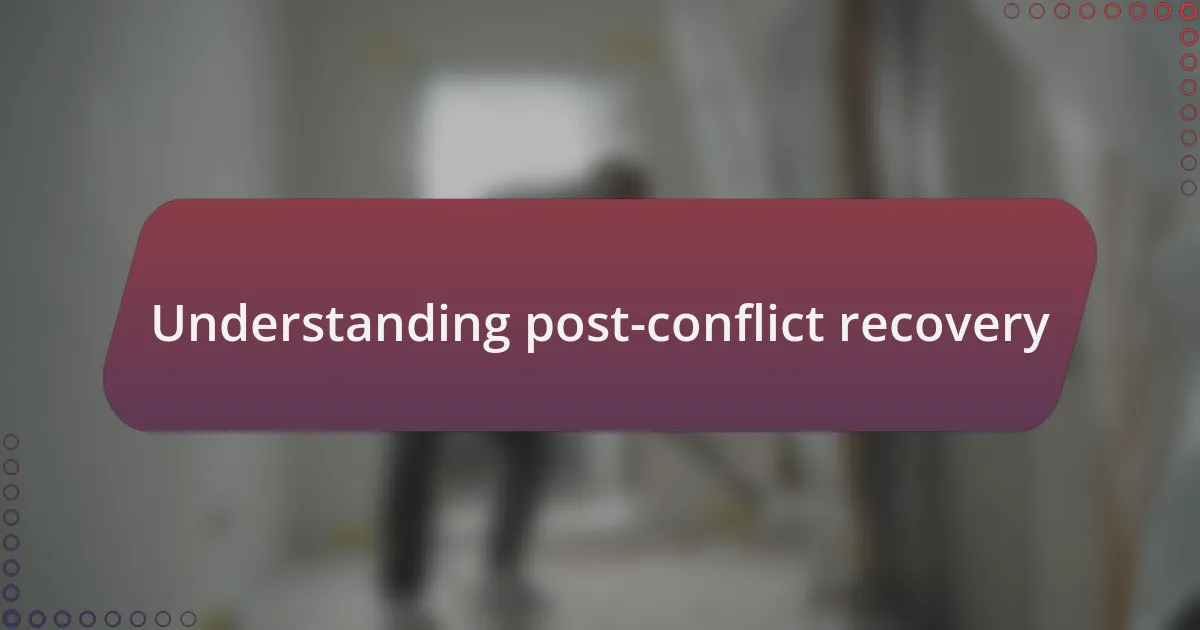
Understanding post-conflict recovery
Post-conflict recovery is a complex journey that requires both rebuilding infrastructure and rekindling hope in communities torn apart by violence. I remember visiting a small town that had once been a battleground but was slowly transforming with the resilience of its people. Witnessing how they rebuilt their homes and relationships made me realize that recovery goes beyond physical reconstruction; it encompasses the emotional healing of individuals and the community as a whole.
In my experience, one of the most challenging aspects of post-conflict recovery is addressing the deep-seated traumas faced by individuals. How do we begin to mend hearts that have witnessed unspeakable horrors? It’s vital to create spaces where stories can be shared and voices can be heard. When I observed a local initiative where survivors gathered to tell their stories, I saw firsthand how this shared vulnerability fostered connection and understanding. It reaffirmed my belief that healing often begins with simply listening.
Furthermore, the role of community engagement in recovery cannot be overstated. It reminds me of a grassroots organization that emerged in a post-conflict area to bring together youth from different backgrounds through sports and cultural activities. It was inspiring to see how these young people, once divided by conflict, began to bond over shared experiences. This sense of unity not only helped foster a new generation of leaders but also highlighted the crucial role of social cohesion in creating a stable and thriving community post-conflict.
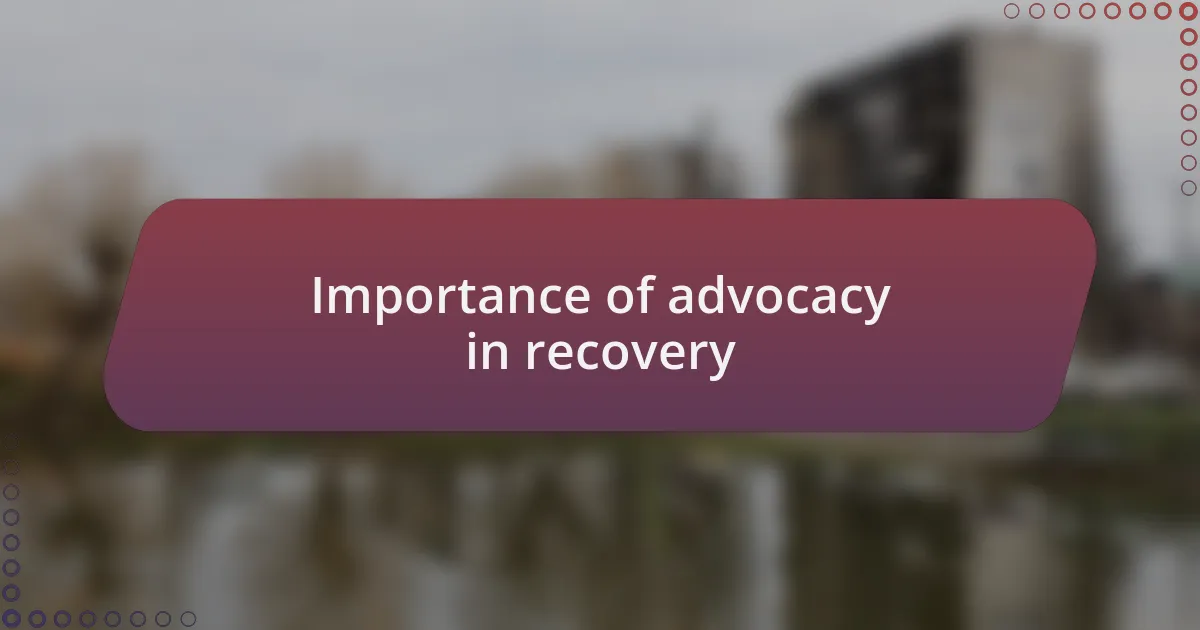
Importance of advocacy in recovery
Advocacy plays a pivotal role in the recovery process, often serving as the voice for those who have experienced the brunt of conflict. I remember attending a town hall meeting where survivors voiced their struggles, and it became clear to me that advocacy is not just about amplifying concerns; it’s about facilitating change. By ensuring that their stories reach decision-makers, advocates can help shape policies that address the deep-rooted inequalities and injustices often exacerbated by conflict.
There was a moment during my time volunteering in an advocacy group that truly opened my eyes to its importance. We organized a campaign focusing on mental health resources in a community recovering from trauma. I witnessed how the mere act of speaking up transformed people’s lives; individuals who had once felt isolated and helpless found strength in solidarity. Advocacy empowers individuals, not only by bringing attention to their needs but also by restoring their agency in the recovery process.
Moreover, effective advocacy fosters a culture of accountability among the stakeholders involved in recovery efforts. It reminds us that those who have suffered must be actively included in decision-making. Can you imagine the uncharted paths of healing we might carve if every survivor had their voice heard? From my perspective, creating systems that prioritize input from affected communities can enhance the relevance and impact of recovery initiatives, driving holistic healing that resonates across generations.

Key principles of effective advocacy
One of the key principles of effective advocacy is authenticity. When I reflect on my experiences in community meetings, I find that sharing honest stories creates a genuine connection. I once listened as a survivor shared their journey. The raw emotion in their voice resonated with everyone present, highlighting that advocacy thrives on real experiences. Wouldn’t you agree that the most powerful arguments often come from the heart?
Another essential aspect is collaboration. In my work with various organizations, I’ve witnessed firsthand how combining resources and expertise can significantly amplify our message. I remember a joint effort with several local NGOs to campaign for housing rights after conflict. Each group brought different perspectives and strengths, and together, we reached a broader audience. It’s fascinating to see how collective action can shift the narrative and pressure those in power to listen.
Finally, persistence cannot be overlooked. I learned this lesson during a prolonged debate about healthcare access in a post-conflict region. Despite facing multiple setbacks, our team remained committed. We kept revising our strategies, engaging new supporters, and refining our proposals until we finally saw traction. Have you ever faced a situation where tenacity led to unexpected breakthroughs? In advocacy, this unwavering spirit can make all the difference, ensuring that critical issues are never brushed aside.
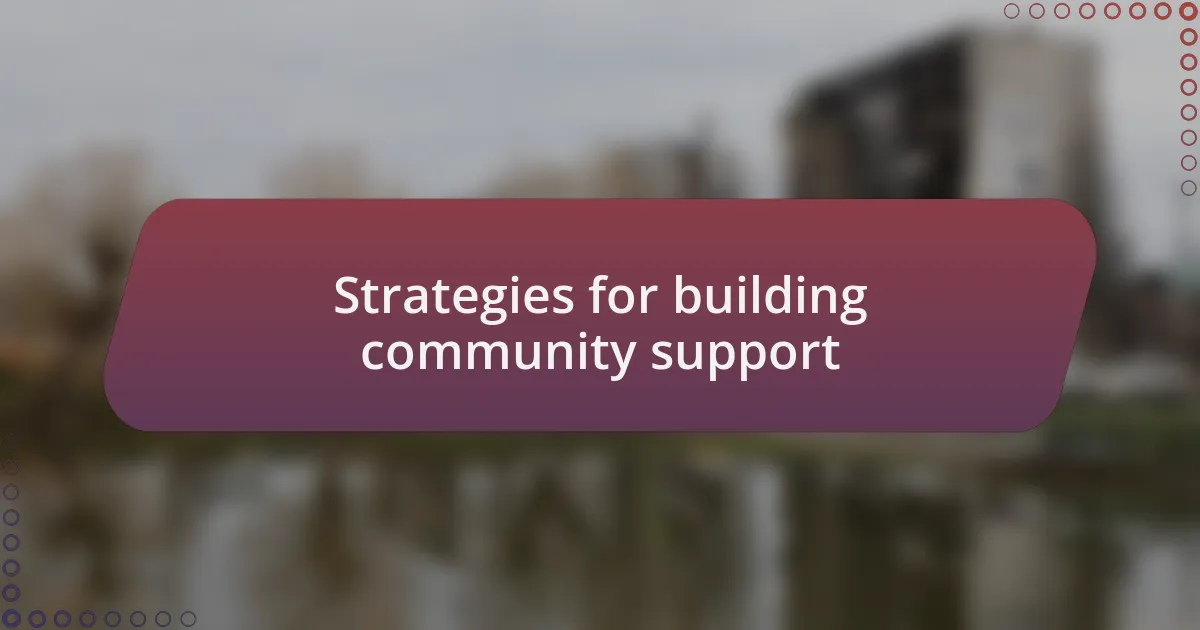
Strategies for building community support
Building community support requires a deep understanding of local needs and values. I recall a community workshop where residents voiced their priorities regarding education and employment opportunities. Listening attentively, I felt a shift in how our advocacy could align with their aspirations. Have you ever noticed how addressing specific community concerns fosters trust?
Creating spaces for dialogue is another effective strategy. I always make an effort to facilitate open discussions, where everyone feels encouraged to share their opinions. During one such gathering, a local leader shared a perspective that challenged our assumptions, ultimately leading to a more inclusive approach in our advocacy. Isn’t it fascinating how the simplest conversations can unveil profound insights?
Moreover, leveraging local networks can significantly bolster support. I’ve seen the impact of mobilizing community influencers, whether they’re respected elders or passionate youth leaders. In a campaign for mental health resources, one influential figure became our champion, motivating others to join our cause. It makes me wonder: how can we better tap into these existing relationships to amplify our efforts?
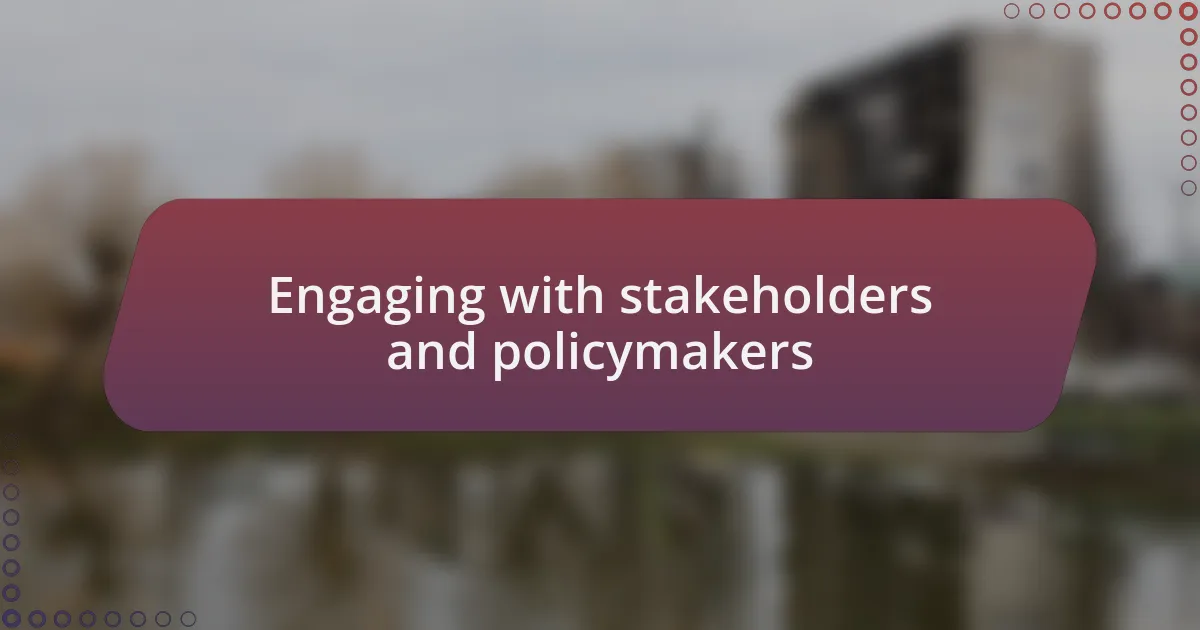
Engaging with stakeholders and policymakers
Engaging with stakeholders and policymakers is crucial for effective advocacy. I remember attending a meeting where local policymakers gathered to discuss post-conflict recovery efforts. By sharing personal stories from community members affected by the conflict, I witnessed firsthand how emotional narratives can shift perspectives and priorities in a way that data alone cannot. Have you ever experienced a moment where a story changed your understanding of an issue?
Building relationships with stakeholders takes time and trust. Early in my advocacy work, I reached out to a local government official who seemed distant and uninterested. After several coffee meetings where we connected over our shared passion for community empowerment, he eventually became one of our strongest allies. This experience taught me that genuine engagement often requires patience and persistence. How might your own relationships evolve if you invest that time?
Moreover, communicating clearly and confidently is key when discussing our advocacy goals. I’ve learned that preparing concise, impactful messages can resonate more effectively with busy stakeholders. During a recent presentation, I focused not on statistics, but on a compelling vision for our community’s future. I could see the change in their expressions as they connected with our mission. Isn’t it remarkable how the right message can unite diverse interests for a common cause?
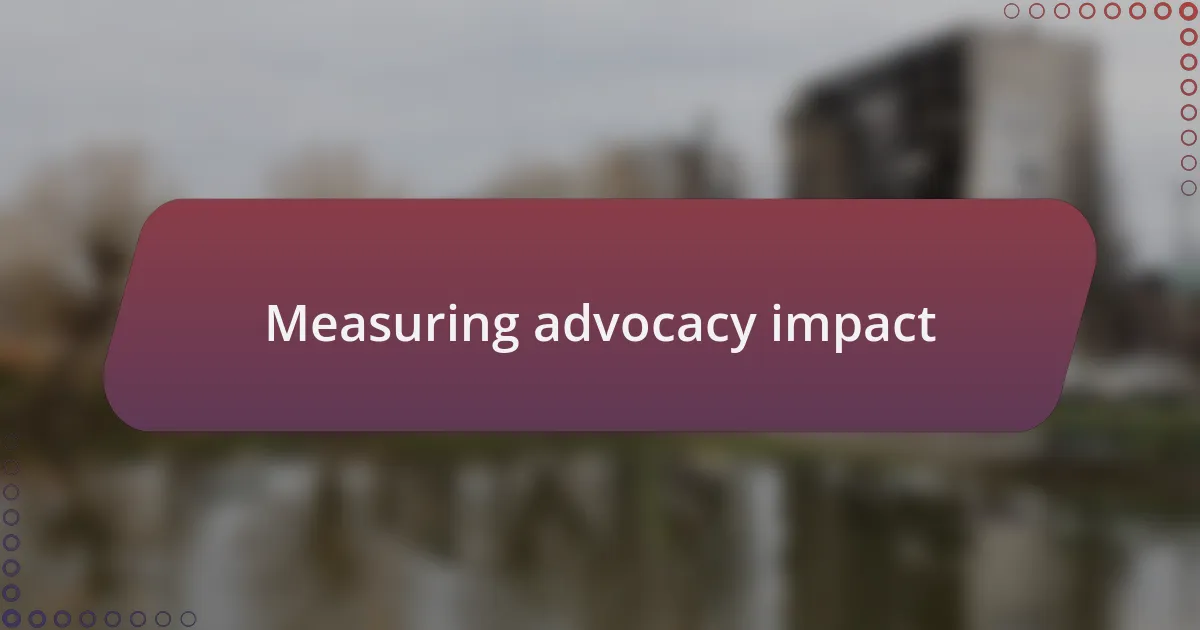
Measuring advocacy impact
Measuring the impact of advocacy can be challenging yet deeply rewarding. In my experience, quantifying success often involves both qualitative and quantitative metrics. For instance, after a grassroots campaign, I surveyed community members to assess shifts in awareness about post-conflict recovery. The increase in respondents recognizing key issues was affirming, showing that our outreach was making a difference. Have you ever considered the power of gathering feedback as a tool for measuring change?
I remember a particularly enlightening moment during a debrief following a major advocacy event. We analyzed not just the attendance numbers but also the discussions that emerged. Attendees expressed heightened awareness and a willingness to take action, which was a clear indicator of our influence. Seeing tangible enthusiasm from the community reinforced my belief that advocacy impact isn’t solely about numbers—it’s about sparking a movement. How might you amplify those moments of engagement in your own advocacy efforts?
Furthermore, reflecting on narratives of change can also provide insights into advocacy effectiveness. I once collected stories from beneficiaries of our initiatives, showcasing their journeys and transformations. When these testimonials were shared with stakeholders, the emotional weight they carried transformed perceptions. It became evident that measuring impact can also be deeply human, illustrating the very real changes in people’s lives. What stories could you share that would resonate with policymakers and other stakeholders?
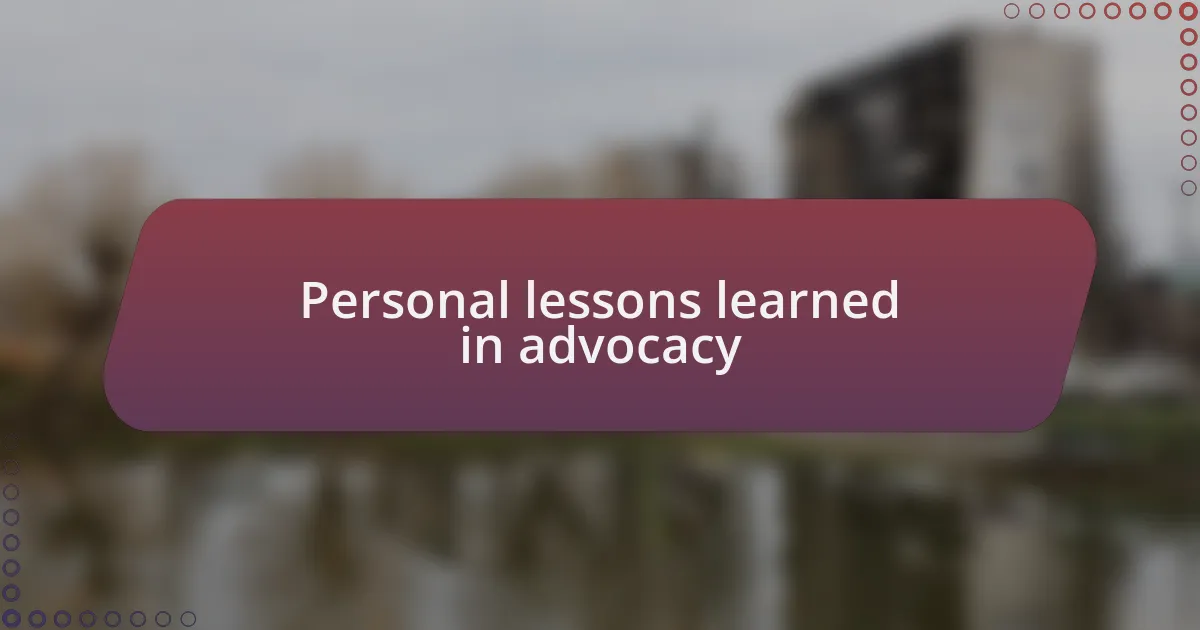
Personal lessons learned in advocacy
Throughout my journey in advocacy, I’ve learned that building genuine relationships is crucial. I remember when I spent time listening to community leaders rather than just presenting my agenda. Those conversations unraveled complexities I had overlooked and, ultimately, fostered trust that made our collaborative efforts more effective. How often do we prioritize connection over communication?
Another lesson emerged during a challenging negotiation with stakeholders. Initially, I relied heavily on data to support our cause, but it was a heartfelt story from a local resident that truly shifted perspectives. The moment their personal experience resonated with the room, I realized that advocacy is as much about emotional connection as it is about statistics. Have you found moments when a story helped you break through barriers in your own advocacy work?
Lastly, I learned that resilience is essential in advocacy. There were many times I encountered setbacks, especially when proposals faced resistance. However, instead of viewing these moments as failures, I began to see them as opportunities for learning and adaptation. Each setback shaped my approach to future campaigns. What strategies do you employ to maintain motivation and perseverance when faced with challenges?